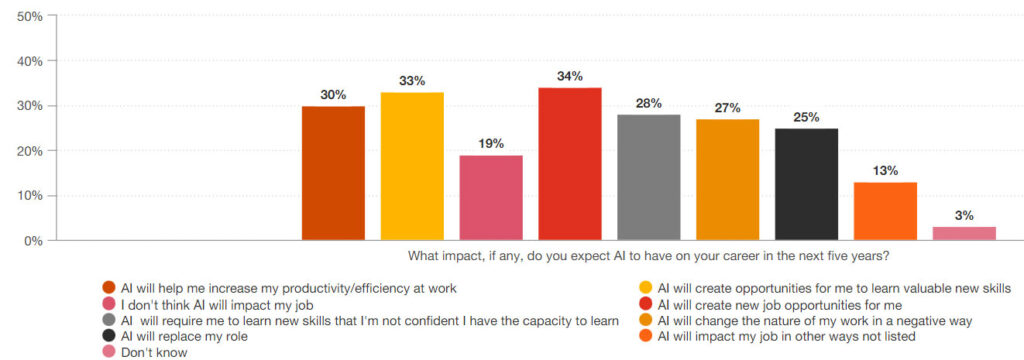Digital transformation often brings a mix of excitement and apprehension. Common concerns include job security, loss of human interaction, and adapting to new technologies.
Despite these fears, successful digital transformation hinges on a human-centric approach that values and involves employees, fostering a culture of collaboration, innovation, and growth. In this blog, we explore strategies to ensure your digital transformation not only succeeds, but also enhances the human experience.
Most of us have secret thoughts and untold fears about “digital transformation.” In today’s fast-paced digital world, the term “digital transformation” can often evoke a mix of excitement and apprehension.
Many people worry about the potential downsides: The fear of losing the human touch in an increasingly automated environment, concerns about job security, and the daunting task of adapting to innovative technologies. It’s now commonplace to hear snippets of conversation that involve concerns about how digital transformation might erode personal interactions or make the workplace more impersonal.
One of the most prevalent fears is that digital transformation will lead to a loss of jobs as machines and software take over tasks humans traditionally performed. Employees might feel that their skills are becoming obsolete, leading to uncertainty and resistance.
Additionally, there is a fear that automation will replace the nuanced and empathetic aspects of human interaction, making customer service and internal communication feel robotic and detached.
Coming from the 2023 Luxembourg outlook on PwC’s Hopes & Fears survey, the figure below shows what impact, if any, do workers across 46 countries expect Artificial Intelligence (AI) to have on their career in the next five years.

People’s gloomy views on the subject are varied, with 27% still thinking that AI will change the nature of their work in a negative way and 25% thinks that AI will replace their role.
Moreover, the rapid pace of technological change can be intimidating. Employees and managers alike may feel overwhelmed by the need to constantly learn new systems and processes. The pressure to adapt quickly can create stress and anxiety, leading some to view digital transformation as a disruptive force rather than an opportunity for growth.
However, these fears, while understandable, overlook a crucial aspect of successful digital transformation: Its human-centric focus. At the heart of any meaningful transformation are the people driving it and those affected by it. Far from diminishing the human element, a well-executed digital transformation can enhance it, fostering greater collaboration, efficiency, and satisfaction.
Embracing a human-centric approach for a successful digital transformation
We won’t beat around the bush: Digital transformation isn’t an easy exercise. According to a study by McKinsey, over 70% of digital transformation initiatives fail to reach their goals, often due to resistance to change and a lack of clear strategy.
A successful digital transformation isn’t just about technology; it’s about improving the human experience within an organisation. When companies take the time to understand the needs and concerns of their employees, they can implement changes that not only streamline processes, but also empower people. This involves actively engaging with employees, encouraging them to voice their pain points and ideas, and making them an integral part of the transformation process.
CEOs understand this. The PwC 26th Annual Global CEO Survey highlights how they are gearing up to make substantial investments in People, Process, and Technology. But while technology and processes are vital components of transformation, the true driving force behind successful change lies in the people who navigate these shifts.
Embracing a human-centric approach ensures that employees feel valued, heard, and integral to the transformation journey. By prioritising human experiences, organisations can foster a culture of innovation, collaboration, and resilience. Ultimately, the most successful digital transformations are those that not only capitalise on cutting-edge technologies, but also enhance and elevate the human experience, leading to sustainable growth and a thriving, engaged workforce.
Given that nearly half of employees in Luxembourg are considering a job or career change, as jobs.lu reported, it becomes even more critical to handle transformations with care. Prioritising the human experience during these changes can turn potential challenges into opportunities for success.
The path to an effective digital transformation
So, what are the key steps to guide an organisation, its employees, and its client through a successful digital transformation? Let’s discover the strategies that can transform challenges into extraordinary successes by keeping the human element at the heart of the process.
1. Define your vision
Click here to expand or collapseThe first step in any successful digital transformation is to define a clear and compelling vision. This vision should articulate what the organisation aims to achieve through the transformation, encompassing both short-term goals and long-term aspirations.
It provides a roadmap that aligns the entire organisation toward a common objective. Start by asking yourself and your co-workers fundamental questions such as: Why do we need to transform? What are our ultimate goals? How will this transformation benefit our customers and employees?
Align your community on the “why.” A well-defined vision serves as a guiding star, ensuring all efforts and people are directed towards achieving the desired outcomes. It also helps to raise awareness, communicating the transformation’s purpose and fostering a sense of urgency and commitment.
2. Analyse your current state (As-Is)
Click here to expand or collapseBefore embarking on the transformation journey, it’s crucial to understand your starting point. Conduct a thorough ‘As-Is’ analysis to map out the current state of your processes, technologies, and organisational structure. This involves many detailed interviews, questions, assessments and documentation of existing workflows, technology stacks, and business operations.
Engage stakeholders from different departments to gather diverse perspectives and insights. Listen carefully to their pain points. This comprehensive understanding will highlight the strengths and weaknesses of your current setup and identify areas that require change. By knowing where you stand, you can better plan the path to where you want to go.
3. Create your future state (To-Be)
Click here to expand or collapseOnce you have a clear picture of your current state, the next step is to envision your future state. The ‘To-Be’ analysis involves designing the ideal processes, technologies, and organisational structures that align with your vision. This future state should capitalise on the latest technological advancements and industry best practices to drive innovation and efficiency.
Collaborate with your stakeholders to co-create this vision. Use design thinking methodologies to brainstorm and prototype potential solutions. The ‘To-Be’ state should not only address current pain points, but also anticipate future needs and opportunities. It reinforces the engagement of the people involved: they start to project themselves in the new organisation.
4. Assess the gap and prioritise the steps
Click here to expand or collapseWith both the ‘As-Is’ and ‘To-Be’ analyses in hand, it’s time to assess the gap between your current state and your desired future state. Identify the specific changes needed to bridge this gap. This could include upgrading technology, restructuring teams, redefining processes, or upskilling employees.
Prioritise these changes based on their impact and feasibility. Develop a step-by-step roadmap that outlines the sequence of actions required to achieve the transformation. Moreover, listen to your stakeholders and share the steps with them. Don’t forget that the organisation should still be able to run normally. This prioritisation ensures that resources are allocated effectively, and efforts are focused on the most critical areas first.
5. Support the change
Click here to expand or collapseSuccessful digital transformation requires robust change management strategies. Change can be challenging, and resistance is natural. To support the transition, communicate the vision and benefits clearly to all stakeholders, at all steps. Provide training and resources to help employees adapt to new technologies and processes. Give them the ability to embrace the change.
Establish a support system that includes change champions and dedicated teams to address concerns and provide assistance. Regularly update the organisation on progress and celebrate milestones to maintain momentum and morale.
6. Build a culture of collaboration and innovation
Click here to expand or collapseA thriving digital transformation hinges on a culture that encourages collaboration and innovation. Foster an environment where ideas can flow freely, and employees are empowered to experiment and take risks. Break down silos and encourage cross-functional teams to work together towards common goals.
Promote continuous learning and development to keep your workforce agile and adaptable. Recognise and reward innovative solutions and collaborative efforts. A culture that values and supports innovation will drive sustained success in your transformation journey.
7. Monitor your journey and be agile
Click here to expand or collapseDigital transformation is an ongoing process, not a one-time project. Continuously monitor progress against your roadmap and adjust as needed. Use Key Performance Indicators (KPIs) to track success and identify areas for improvement.
Use your experience at each step of the process, document your lessons learnt and make them visible, and detect when the way of working isn’t aligned with your stakeholders.
Additionally, be agile. Make sure to be prepared to adapt to changing circumstances and emerging technologies. Agility is crucial in a rapidly evolving digital landscape. Regularly review and refine your strategies to stay ahead of the curve and ensure that your transformation efforts remain aligned with your vision.
How do we know the tips work? Because we applied them. Read our success story with one of our clients in Luxembourg.
“The tool is so complicated… I’d rather send an email directly to the HR department,” said the team manager.
“I’m part of the HR department and I can relate. I’m losing so much time processing tons of emails,” added a back-office staff member.
“I spend over an hour a day just trying to find the right information when I need it,” shared a front-office employee.
“The organisation needs to modernise,” assured the CEO.
How did we get this feedback? We simply asked.
Our Human Experience team began the client’s digital transformation by immersing themselves in the daily work lives of various employees to uncover the pain points mentioned above, explore their journeys, and understand their emotional experiences through different activities. This is empathy in action.
With over 80 one-on-one interviews across different departments, several weeks of shadowing at all levels of the organisation, and hours spent challenging employees on their tasks, this digitisation started with a human-centric approach.
And guess what? All stakeholders were delighted to be interviewed and heard. This digital transformation programme has never been about replacing human interactions or eliminating jobs; it’s about enhancing the human experience with meaningful work and value-added activities.
When the time came to build the ideal future experience, the company’s stakeholders had already had the time to think about opportunities for growth and improvement in their day-to-day work.
They understood the “why” and had found answers to the question, “What’s in it for me?” They started to desire change. After a three-day immersion workshop at the PwC Experience Center, they co-created a roadmap for the next two and a half years of their digital journey.
Three years later, what is the outcome of this transformation? Why is it a success story?
Following the implementation of a new collaboration tool, a new human resources system, and the streamlining and modernisation of processes, among other powerful initiatives, the company realised gains equivalent to more than 20 full-time employees.
What does that mean? How did we achieve that?
No one was fired, and no one left the company. However, some jobs did change. In the HR department, there is no longer a need for two full-time employees to process all the demands—one is sufficient. The other employee has become a trusted business partner, now in charge of the company’s training and development catalogue.
Thanks to more efficient collaboration and knowledge management tools, five project managers completed business process modelling training and became part of the new Operational Excellence Center. They are now responsible for continuously optimising processes across the organisation.
Four other employees have been trained to use automation software and now develop Robotic Process Automation (RPA) solutions for repetitive tasks in the back office as part of an Automation Excellence Center.
Conclusion
This success story is just an example to illustrate how successful your digital journey can be when you don’t neglect the human experience. Humans can adapt to and embrace change, driving digitisation and capitalising on upskilling to overcome their secret fears. The search for the “why” at each step of the transformation is key: It involves your employees, clients, and hierarchy in the journey, making them thrive.
Our PwC Human Experience team acts as an agile coordinator, building human bridges within our clients’ organisations and guiding the transformation in a multidisciplinary environment where process modelling and technology align with organisational change and people upskilling.
Most importantly, our team listens, cares, and acts as an enabler for your digitisation because no one knows your business and your people better than your business owners.
What we think

Successful digital transformation is not just about adopting new technologies; it’s about fostering a culture of collaboration, continuous learning, and adaptability. When diverse people, experiences, skills and perspectives are seamlessly integrated, the organisation can fully harness the potential of digital advancements.
Lisa Weistroffer, Manager in Digital Transformation at PwC Luxembourg
Digital transformation requires the integration of diverse expertise: change management, business analysis, user experience, or people upskilling. Success belongs to those who can engage all these elements.
Vinciane Istace, Partner and People, Experience & Change Leader at PwC Luxembourg


